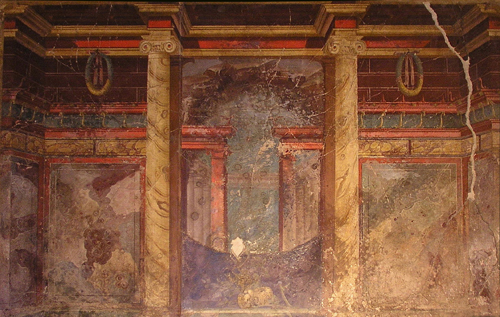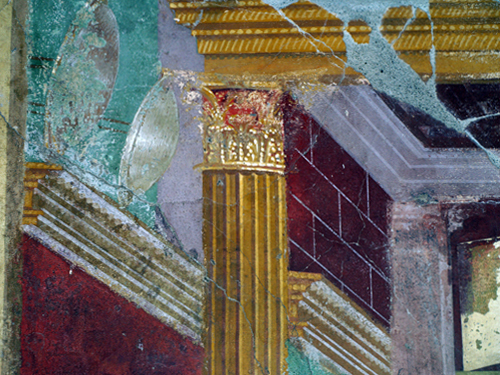The numerous funerary and votive motifs in ancient Roman tragic-style wall-painting and De Chirico’s twentieth-century works, signify an other-worldly presence. In both cases it is psychologically reinforced by the use of perspectival systems. Even if assessed by post-Renaissance standards, both demonstrate an extremely sophisticated understanding of, if not the laws of perspective, then the visual psychology surrounding them. Paintings such as those found in the Villa di Poppea (Oplontis) and the House of Fabio Rufo engage the viewer on a highly effective phenomenological level, despite the fact that they do not conform to the mathematical and geometrical rules governing perspective, that were developed in the Renaissance (figs.1-2). Indeed, had the ancient painters and De Chirico adhered to the rules their paintings would not have achieved the psychological meta-texts that we associate with them. In other words the latent content determined the organisation of the form itself. In De Chirico’s case it was predicated on the marriage of metaphysics and poetry and in the case of the ancient wall-paintings it was determined by trompe l’oeil virtual-realities in pursuit of metaphysical worlds. If one wanted to produce a pictorial image of the visible world then clearly the precise laws of perspective would apply. If, on the other hand, one is trying to create a metaphysical dream-world, then the optically precise laws of perspective would hamper this objective. What is important in both these ancient and contemporary paintings is that through dramatic illusion and metaphor, a state of transitory awareness is created between the physical and the metaphysical.
The spatial metaphysic associated with tragic-style Romano-Campanian painting appears to be a metaphysic in which perspective points to a world that is not normally visible; a world inhabited by ancestors and divine beings. Therefore, in terms of our cross-textual model, it is possible to establish a connection between perspective and metaphysics; a connection that does indeed turn out to be perplexing, even ominous, in terms of the relationship it evokes between the living, supernatural beings and the dead. On a more conceptual and perhaps less emotive level, the connection lies in the potential that perspective has for transferring our thoughts from the corporeal to the incorporeal, from the physical to the metaphysical. The iconography associated with this transference in Romano-Campanian painting not only symbolised death, but also its counterpart in the form of spiritual rebirth, the continuation of the soul’s journey into the underworld and immortality – its apotheosis.
 1
1 2
2